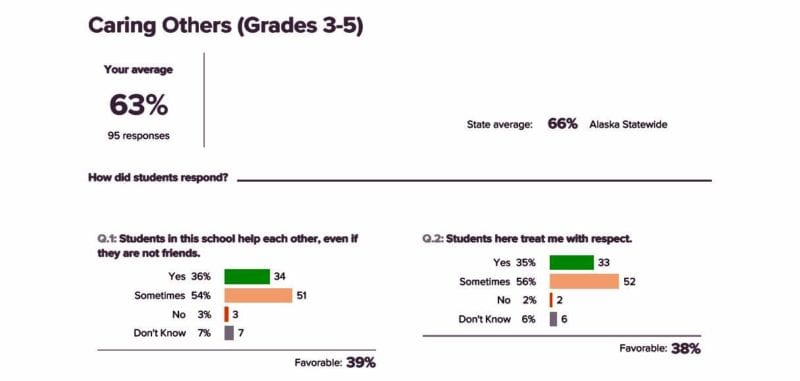 A survey of Petersburg School District students and staff show that perceptions can vary among grades and length of time workers have been at the district. The school board at their last meeting heard the results of an annual School Climate and Connectedness Survey from the Association of Alaska School Boards. KFSK’s Angela Denning reports:
A survey of Petersburg School District students and staff show that perceptions can vary among grades and length of time workers have been at the district. The school board at their last meeting heard the results of an annual School Climate and Connectedness Survey from the Association of Alaska School Boards. KFSK’s Angela Denning reports:
The annual questionnaire asks students and staff about perceptions–how they feel about various topics like peer support, school safety, and their involvement in the school.
The survey was completed by 50 staff members and 278 students in the district.
The results were presented by AASB’s School Climate Coordinator, Jenni Lefing.
“It’s all those things that we know are important but don’t always get measured but directly impact how students do in school academically,” Lefing said.
Lefing told the school board that the more positive students and staff feel about school climate, the more likely students are to graduate.
In the survey, students choose to either agree or disagree with a question or be somewhere in between. The scores represent the percentage of students who responded favorably to a question. For example, 49 percent of middle and high school students agreed that there was a respectful climate in the school.
The lowest scores for the middle and high school group were for student interactions, student involvement and cultural connectedness. The most favorable responses were for dealing with delinquent behaviors and drug and alcohol use.
29 percent of middle and high school students said they thought that students were respectful and helpful to one another. That’s below the statewide average of 33 percent. The category posed questions such as, “Do students in the school treat each other with respect?”
35 percent of middle and high school students agreed that they are involved in the decision making at the school. The statewide average was 47 percent. For staff, though, there were more favorable responses with the adults scoring 63 percent.
“Student perceptions is lower than staff perceptions, we often see that, especially in this students involvements scale,” Lefing said.
Lefing says there can be differences in how students and staff define categories like student involvement. And perceptions can also vary by grade.
By looking at the responses, Lefing told the school board that they can compare those different perceptions. While 29 percent of middle and high school students thought that students treated each other well, 78 percent of staff thought so.
“You can see for every specific question how it compared to statewide, break down by gender. You can go in depth with each of your schools,” Lefing said. “It’s exciting because there’s just a lot of different layers of data to look at.”
It was the first year that Petersburg students in grades three through five were surveyed.
It was also the first year that students and staff were asked questions about cultural connectedness. Lefing said the AASB worked with stakeholders like the First Alaskans Institute to come up with those questions.
Lefing noted that more favorable responses came from new staff and veteran staff that had been at the schools for over 15 years.
“It’s awesome to see that you have quite a few staff that have been in your district for a long time, which really, it has such a positive impact on your students success,” Lefing said.
She didn’t say whether Petersburg’s scores were good or bad. She says it’s important to keep in mind that it’s just one form of data for the district to consider.
“I think what’s most important about this school climate data is that it’s a conversation starter,” Lefing said. “It’s a way to get a glimpse into what your students and staff are feeling, saying. I would definitely encourage the district because you have this data, to look at your school climate data along with everything else when you’re making decisions around your strategic planning this fall.”
Statewide, over 35,000 students in 27 school districts took the survey. Over 5,000 staff members took the survey as well.











